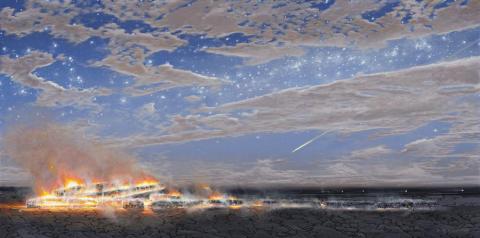STARLIGHT OVER THE PLAIN (NIGHT COALS), 2008
TIM STORRIER
synthetic polymer paint on linen
153.0 x 305.0 cm
signed lower right: Storrier
signed, dated and inscribed with title verso: ‘Starlight over the Plain’ / (Night Coals) / Storrier / 2008
Philip Bacon Galleries, Brisbane (label attached verso)
Private collection, Queensland
There neither is, nor has there ever been, anything brusque or arbitrary in the work of Tim Storrier. Intensely considered and informed by an unwavering conviction, there are few artists who are able to convey with such ability 'the unyielding essence of being in the Australian landscape; its vast, impenetrable melancholy; its inexorable primacy over and beyond all human intervention.'1
Belonging to a group of post-millennial landscapes, this poetic and melancholy painting is a sophisticated exploration and merging of a number of Storrier's key themes. The foreground dominated not by embers but still a living fire, the horizon is all but obscured by its incandescent force. Framed by a sky still light though with an enveloping dusk, Storrier's fire is one of both ruination and renewal; the cleansing flame from which the Persian phoenix will arise.
Like so many of Storrier's paintings, here the landscape acts once more as a site where the artist's rituals of destruction and resurrection may take place. We are left as always beguiled by their beauty, caught upon the tenterhooks of Storrier's finely crafted ambiguities. As noted by curator William Wright, 'For Storrier, the landscape, like still life and other connected genre also preoccupy him, is not solely a motif for painterly interaction, as for him painting is not merely a means of rendering the 'seen'. His is also, and far more importantly, an art of remembering, of 'musing' the unseen, the hidden, thereby exorcising the apparitions of past and personal experience. The landscape is therefore the site of deeply rooted, internalized memories revisited through the observation of the repeated image, memories of places and perceptions experienced through the passage of lived time.'2
1. Wright, W., Point to Point, from a speech given at the presentation of a major work to the Australian Embassy, Tokyo, 1996, (at < http://storrier.h.fatpublisher.com.au/presentation-toembassy-of-australi..., viewed 27 March 2013)
2. Ibid.
MERRYN SCHRIEVER
